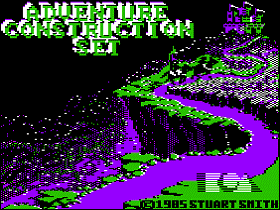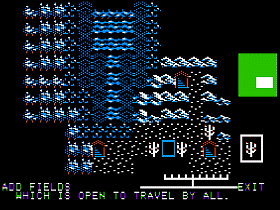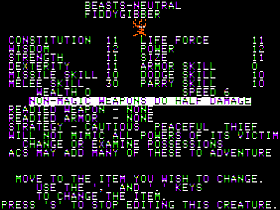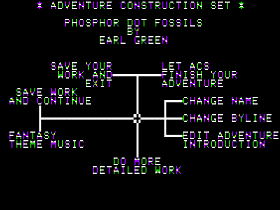 The Game: Digital dungeon masters never had it so good. From the design of tiles and characters to the basic rules governing the player’s interactions with his world, it’s all up for grabs. Items can be placed, their abilities defined, and enemies can be generated. Let the games begin…but is it more fun to create them or play them? (Electronic Arts, 1985)
The Game: Digital dungeon masters never had it so good. From the design of tiles and characters to the basic rules governing the player’s interactions with his world, it’s all up for grabs. Items can be placed, their abilities defined, and enemies can be generated. Let the games begin…but is it more fun to create them or play them? (Electronic Arts, 1985)
Memories: Offering everything from pre-built elements to user-defined items and characters from scratch, Adventure Construction Set was a revelation. Where Garry Kitchen‘s Game Maker from Activision allowed budding game designers to create their own arcade-style games, EA‘s Adventure Construction Set gave them control of a top-down, tile-based 2-D adventure game. Those familiar with the Ultima series or Questron would instantly be within their element.
 If there was a drawback to ACS, it was simply that the games it was designed to emulate – to some degree – had already passed it by. The more sophisticated Ultima III was already on the market, and Ultima IV, with its sophisticated conversation trees and moral accountability, was just around the corner, and ACS really couldn’t compete: it simply didn’t offer the depth to make it possible to match that level of sophistication. Perhaps this was the result of a long development process, or the inherent limitations of – like Game Maker – having ACS translate between the computer and the game designer, and sucking up a healthy amount of available memory in the process of mediating that conversation. It was, however, entirely
If there was a drawback to ACS, it was simply that the games it was designed to emulate – to some degree – had already passed it by. The more sophisticated Ultima III was already on the market, and Ultima IV, with its sophisticated conversation trees and moral accountability, was just around the corner, and ACS really couldn’t compete: it simply didn’t offer the depth to make it possible to match that level of sophistication. Perhaps this was the result of a long development process, or the inherent limitations of – like Game Maker – having ACS translate between the computer and the game designer, and sucking up a healthy amount of available memory in the process of mediating that conversation. It was, however, entirely  possible to come up with a game on about the same level, as, say, Ultima I. Well, Ultima I minus the dungeon crawls. This realization may have been a dash of cold water for fantastists with sprawling epics in mind.
possible to come up with a game on about the same level, as, say, Ultima I. Well, Ultima I minus the dungeon crawls. This realization may have been a dash of cold water for fantastists with sprawling epics in mind.
Fortunately, ACS allowed for several different game genres, including sci-fi epics and others. The notion of using an Ultima-lite engine to tackle other settings was perhaps its most promising feature.
The spirit of ACS lives on in modern gaming as well, thanks to products such as RPG Maker which, like ACS  back in the day, had a burgeoning community of would-be dungeon masters creating and circulating their own home-made worlds. Its legacy is still around today.
back in the day, had a burgeoning community of would-be dungeon masters creating and circulating their own home-made worlds. Its legacy is still around today.
